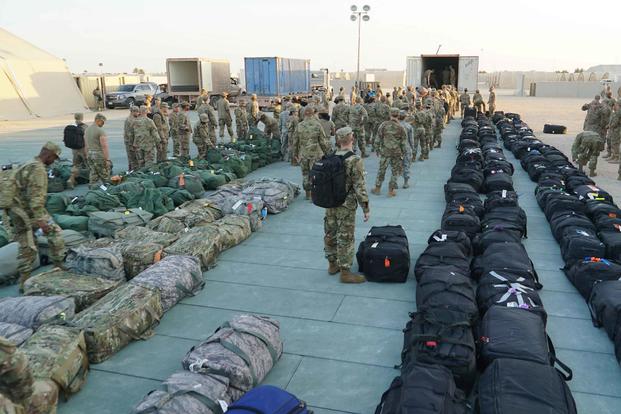Lawmakers called on Defense Secretary Mark Esper to clarify whether the Pentagon is considering sending as many as 14,000 U.S. troops to counter Iranian threats in the Middle East.
A Wall Street Journal report, published Wednesday, said the Defense Department is weighing an increase in force posture, but Pentagon spokeswoman Alyssa Farah tweeted that the article was inaccurate.
"To be clear, the reporting is wrong," Farah said Wednesday. "The U.S. is not considering sending 14,000 additional troops to the Middle East."
But lawmakers want to be sure.
During a Senate Armed Services Committee hearing Thursday, Republican Sens. Marsha Blackburn of Tennessee and Josh Hawley of Missouri repeatedly grilled Under Secretary of Defense for Policy John Rood about the news report.
Related: Thousands More Troops Deploying to Saudi Arabia as Iran Threatens
"Are you considering sending more troops to the Middle East?" Blackburn asked.
"We're concerned about the threats that we're seeing," Rood said, adding that Pentagon officials plan to brief lawmakers next week in a closed-door session about Iran's activities in the region.
When again pressed by Blackburn on whether the Pentagon is considering sending additional troops, Rood responded: "Yes."
"Is 14,000 the correct number or is there a lesser number?" she asked.
"[Esper] has not made any decisions," Rood said. "[He] continues to evaluate with the advice of others what the appropriate number of forces to be deployed to the Middle East is. … Based on what we're seeing with ... the threat picture, it is possible we would need to adjust our force posture."
However, Hawley was dissatisfied with the answer, asking for a yes or no response.
Rood reiterated that the Pentagon has not made a decision and frequently reassesses troop numbers. But Hawley defended The Wall Street Journal report, saying it is clear the Pentagon is indeed considering the action.
"What you're telling me now is that [Farah] misspoke," Hawley said. "I think at this point it would be helpful to hear from [Esper] on this issue, and I'd like to hear from him today on this issue."
He added, "Some clarification is in order, and I'd like to have it in public, because now the Pentagon has made multiple, public contradictory statements."
The point of contention lies with how many troops are needed to deter Iran's antagonistic actions in the Middle East at a time when DoD officials have made clear that the Pentagon's focus should turn to aggressors such as Russia in China, as part of the National Defense Strategy (NDS).
President Donald Trump has repeatedly said his administration's vision is to reduce the U.S. troop presence in the Middle East, especially in Afghanistan, focusing instead on counterterrorism and peace negotiations with a smaller footprint in the region.
Since May, roughly 14,000 troops have deployed for the counter-Iran mission.
"We've heard a lot from Pentagon leaders about prioritizing China and Russia," Senate Armed Services Committee Chairman Sen. Jim Inhofe, R-Oklahoma, said in a statement Thursday. "But with 14,000 troops deployed to the Middle East since May, we must ask if the urgent is once again outweighing the important. I'd like to hear from the department about how it is prioritizing China and Russia in new ways since the NDS came out. I'd also like to hear more about achieving a 'more resource-sustainable approach' in the Middle East [as] called for in the NDS."
The Trump administration announced May 5 that it was sending the aircraft carrier Abraham Lincoln and a B-52 Stratofortress bomber task force to the region as part of a force buildup. Since then, U.S. troops have reopened the Prince Sultan Air Base in Saudi Arabia's east central desert, which had been in disuse since the 2003 invasion of Iraq.
In October, Esper announced that the DoD would begin another increased rotation, sending two fighter squadrons, an Air Expeditionary Wing, two Patriot missile batteries, and one Terminal High Altitude Area Defense system, known as THAAD, to act as a force stabilizer -- bringing the number of additional troops who have had deployments authorized or extended since September to 3,000.
During an Oct. 11 press briefing, Esper stressed that there were additional military units on alert ready for these regional missions "if necessary."
This is "to send a message to the Iranians, 'Do not strike another sovereign state, do not threaten American interests, American forces,' or we will respond," he said.
"Do not mistake our restraint for weakness. If you will, you will regret that," Esper added.
Following the hearing, Farah issued a new statement regarding the potential deployment.
"As discussed in the hearing today, we are constantly evaluating the threat situation around the world and considering our options,” Farah said. “We adjust our force posture and troop levels based on adversary action and the dynamic security situation.
“Secretary Esper spoke to Chairman Inhofe this morning and reaffirmed that we are not considering sending 14,000 additional troops to the Middle East at this time," she added.
-- Oriana Pawlyk can be reached at oriana.pawlyk@military.com. Follow her on Twitter at @Oriana0214.
Read more: Three Dead, One Injured After Sailor Opens Fire at Pearl Harbor Naval Shipyard













